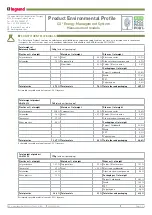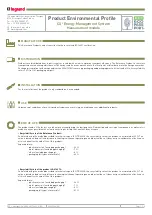
PEP ecopassport No LGRP-00376-V01.01-EN
20E0290A-EN
Page 5 / 5
P
roduct
E
nvironmental
P
rofile
CX
3
Energy Management System
Measurament module
128 av. du Maréchal-de-Lattre-de-Tassigny
87045 Limoges Cedex France
Tel. +33 (0) 5 55 06 87 87
Fax. + 33 (0) 5 55 06 88 88
Your usual Sales office
www.legrand.com
Registration N°: LGRP-00376-V01.01-EN
Drafting rules: «PEP-PCR-ed3-EN-2015 04 02»
Supplemented by «PSR-0005-ed2-2016 03 29»
Verifier accreditation N°: VH02
Information and reference documents :
www.pep-ecopassport.org
Date of issue: 02-2017
Validity period: 5 years
Independent verification of the declaration and data, in compliance with ISO 14025:2010
Internal
External
The PCR review was conducted by a panel of experts chaired by Philippe Osset (SOLINNEN)
The elements of the present PEP cannot be compared with elements from another program
Document in compliance with ISO 14025 : 2010: «Environmental labels and declarations. Type III environmental
declarations»
Environmental data in alignment with EN 15804 : 2012 + A1 : 2013
seLection of environmentaL imPacts
The values of the 27 impacts defined in the PCR-ed3-EN-2015 04 02 are available in the digital database of pep-ecopassport.org website.
Total for Life cycle
Raw
material and
manufacture
Distribution
Installation
Use
End of life
Global warming
2.26E+01 kgCO
2
eq.
2.36E+00
10%
5.63E-03
< 1%
4.44E-03
< 1%
2.02E+01
89%
8.03E-03
< 1%
Ozone depletion
5.57E-06 kgCFC-11 eq.
6.51E-07
12%
1.14E-11
< 1%
2.74E-11
< 1%
4.92E-06
88%
1.92E-10
< 1%
Acidification of soils
and water
1.56E-01 kgSO
2
eq.
3.07E-03
2%
2.53E-05
< 1%
2.11E-05
< 1%
1.53E-01
98%
3.09E-05
< 1%
Water eutrophication 6.65E-03 kg(PO
4
)
3-
eq.
8.53E-04
13%
5.81E-06
< 1%
1.79E-05
< 1%
5.74E-03
86%
3.67E-05
< 1%
Photochemical ozone
formation
7.60E-03 kgC
2
H
4
eq.
3.63E-04
5%
1.80E-06
< 1%
1.49E-06
< 1%
7.23E-03
95%
2.40E-06
< 1%
Depletion of abiotic
resources - elements 6.00E-04 kgSb eq.
5.99E-04
100%
2.25E-10
< 1%
1.92E-10
< 1%
9.22E-07
< 1%
5.02E-10
< 1%
Total use
of primary energy
3.86E+02
mJ
3.67E+01
10%
7.55E-02
< 1%
5.83E-02
< 1%
3.49E+02
90%
8.60E-02
< 1%
Net use
of fresh water
7.46E-02 m
3
2.18E-02
29%
5.04E-07
< 1%
1.20E-06
< 1%
5.28E-02
71%
6.66E-06
< 1%
Depletion of abiotic
resources - fossil
fuels
2.30E+02
mJ
2.13E+01
9%
7.91E-02
< 1%
6.20E-02
< 1%
2.08E+02
91%
1.14E-01
< 1%
Water pollution
1.27E+03 m
3
4.16E+02
33%
9.26E-01
< 1%
6.92E-01
< 1%
8.49E+02
67%
9.27E-01
< 1%
Air pollution
1.06E+03 m
3
1.88E+02
18%
2.31E-01
< 1%
4.51E-01
< 1%
8.68E+02
82%
9.11E-01
< 1%
For products covered by the PEP other than the Reference Product, the environmental impacts of each phase of the lifecycle are calculated by
multiplying those of Reference Product for these coefficients:
Product
Total
Manufacturing
Distribution
Installation
Use
End of Life
LG-414919
1,0
0,9
1,2
1,0
1,1
0,9
LG-414920
1,1
1,0
1,2
1,0
1,1
1,3
LG-414923
1,0
1,0
1,0
1,0
1,0
1,0























